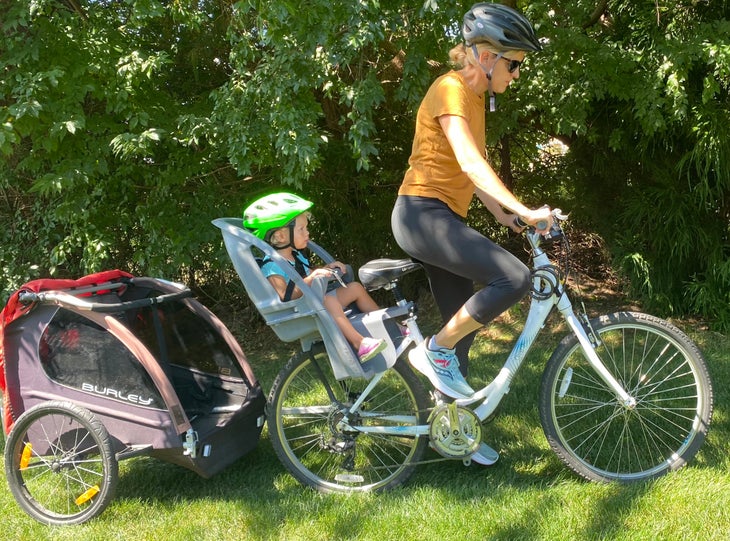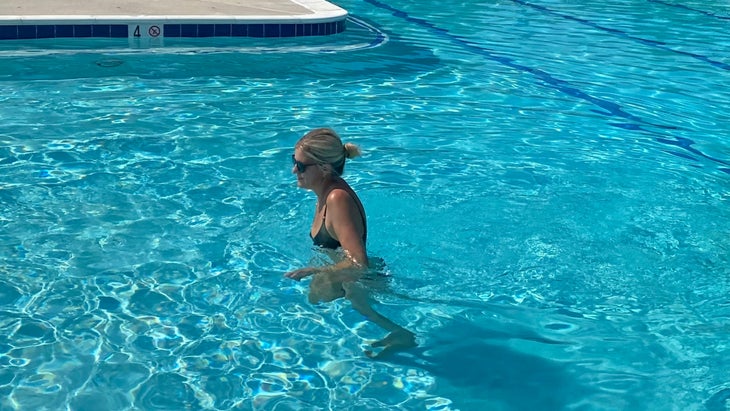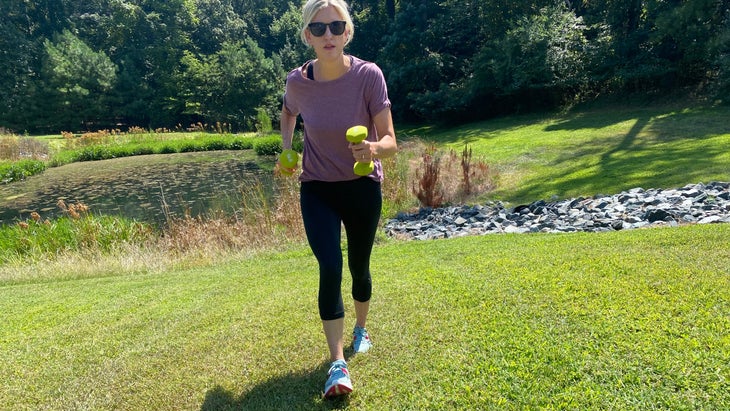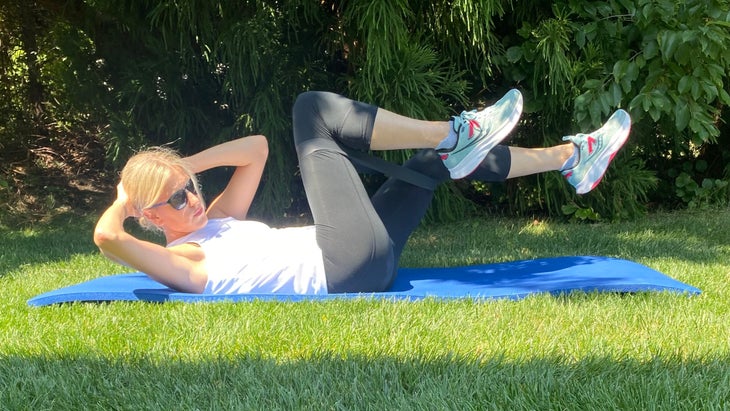No products in the cart.
Outdoor Adventure
4 Low-Impact Exercises That Won’t Hurt Your Back
I was a long-distance runner for so long that, at one point, it was a large part of my identity. I won six state championships in high school and got a track scholarship to a Division 1 college, where I regularly logged 90 miles a week during training.
After graduating, running continued to be a consistent part of my routine. Its importance in my daily schedule was nearly tied with brushing my teeth. I ran through all five of my pregnancies—I even went for a five-miler the day before I delivered my second son. Running was—and still is—my favorite thing to do.
However, I eventually started experiencing sporadic bouts of debilitating back pain. Every six months or so, I woke up with a stiff back; it felt as if it was locked into place. Everyday activities, like leaning over the sink to spit out a mouthful of toothpaste or driving my car, were agonizing.
The flare-ups would last for about two weeks and then get better. I went years without knowing what was causing them. But after a slew of misdiagnoses, I finally got an answer: I was showing early signs of degenerative disc disease, which is a condition where the discs between the vertebrae lose their cushioning and cause pain.
Shortly after my doctor gave me my diagnosis, they delivered the real blow: I had to stop running. The force from pounding the pavement was putting too much stress on my back. If I didn’t stop, I risked those flare-ups becoming my normal. I cried the whole way home from my appointment, devastated that my decades-long love affair with running was over.
My doctor recommended that I pivot to low-impact exercises, listing off things like walking, swimming, and biking as options (basically anything that didn’t require me to jump up and down).
As I feared, these were nowhere near as challenging of a workout as I was used to. So, I created my own workouts, incorporating elements that would tie in the feeling I loved from a good run—being outside in nature and working up a sweat without putting my body through the wringer.
These are the workouts I currently rotate through each day. I interviewed two personal trainers to explain why these moves are low-impact (and therefore back-friendly) yet still challenging enough to help me meet my fitness goals.
Biking Intervals with a Kid (or Two) in Tow

Biking is the workout I do most often, given that my two-year-old is an early riser and likes to go with me. While some cyclists enjoy road bikes, I prefer to use my standard hybrid bike, a Liv, which requires me to pedal harder to get where I want to go.
For my workouts, I put my daughter, who weighs about 25 pounds, on the back of my bike.
Here’s what I do from there:
- Pedal as hard as I can for 30 seconds
- Go at a more comfortable pace for 30 seconds
- Pedal as hard as I can for one to two minutes
- Pedal at an easy pace for one minute
- Repeat the above intervals for 30 to 45 minutes
I can often burn between 350 and 400 calories with this routine. On days when I want to kick things up a notch, I’ll also have my five-year-old ride in my bike’s trailer for added weight. And, if I want to bike but my kids aren’t available, I’ll simply put heavy hand weights in my bike’s seat.
Doing sprints on a bike can be “massively aerobically challenging, but it also works in some strength training,” says Albert Matheny, a personal trainer and the co-founder of SoHo Strength Lab. “You can really exhaust yourself quickly on a bike,” he says. Matheny recommends putting on a weighted vest, which can make things more challenging when out of the saddle.
It can also be helpful to “gradually increase the interval times and progressively increase the overall cycling time” to avoid plateauing, says Doug Sklar, a certified personal trainer and founder of the New York City fitness training studio PhilanthroFIT.
“Running” Laps in the Pool

This is a workout I stole from my college training. Once a week, we would do a pool workout, where we “ran” in the water.
I head to my neighborhood pool and run laps for up to 45 minutes. Sometimes, I do shallow water runs. Other times, I do “sprints” in deep water where I can’t touch the bottom, which is sort of a modified way of treading water. The buoyancy of the water helps to keep this workout low impact.
Here’s what a swim interval day looks like for me:
- Deep-water sprints for 30 seconds
- Swim at a comfortable pace for 30 seconds
- Repeat over the course of 30 minutes
“Pool running can be a great way for those with joint or bone injuries or other limitations to mimic similar movement patterns to running while elevating your heart rate with no impact on your joints,” Sklar says.
Matheny suggests keeping your fists closed and running with your forearms below the water to make each stride more challenging.
Walking Intervals with Weights

I’m pretty sure I rolled my eyes when my doctor first suggested walking. But I gave it a try and found that walking long distances just wasn’t hard enough for me.
So, I added weights and focused on walking uphill on elevated areas near my home.
This is what a typical walking interval workout looks like for me:
- Hold five-pound hand weights in each hand and walk up a hill at a brisk pace (about 4.1 miles per hour) for one minute
- Walk downhill at a brisk pace until reaching the bottom
- Walk uphill at 4.1 miles per hour for two minutes
- Walk downhill at a brisk pace until reaching the bottom
- Repeat over the course of 40 minutes
I get surprisingly sweaty after doing a few of these, which makes sense, considering I burn around 400 calories. As a bonus, I feel like I’m simultaneously getting an arm workout. According to Sklar, walking with weights is low-impact because although my pace is faster than if I were out for a leisurely stroll, both of my feet stay on the ground at all times.
Matheny points out that weight-bearing exercises are important for bone health. “It’s always good to do that and mix it up because you’re giving your body a new stress,” he says.
Sklar says there is an “added strength component” to hill training, especially when extra weight is involved. He recommends gradually increasing both the weights and walking speed and reducing the time between intervals to make this exercise tougher.
Low-Impact Strength Training

My doctor has repeatedly stressed the importance of maintaining a strong torso to support my back, so I try to incorporate exercises that target my core after each of these workouts.
But every few days, I’ll do a more concentrated strength training workout using exercise bands and hand weights on a yoga mat in my yard.
I try to mix this up, but it generally includes these moves:
- 100 bicycle crunches with an exercise band around my thighs for extra resistance
- 30 banded leg lifts on each side
- 30 walking squats with a band around the thighs and a weight in each hand
- 25 bicep curls
- 25 tricep extensions
- 25 resistance band pull-aparts
- Repeat the above for five sets
When I have time, I’ll simply tack this on to the end of one of the other cardio-heavy workouts above. But on lighter days, I’ll just do this.
This workout is low-impact because it doesn’t involve jumping or pounding into the ground at all, says Matheny.
“Band exercises are a great, convenient, and inexpensive way to incorporate strength training into your workout routine,” Sklar says. “Strength training improves bone density and increases lean muscle, both of which are great for injury prevention.”
Sklar recommends gradually advancing to heavier weights and increasing the resistance of the bands to ensure this workout remains challenging.
Nothing will ever replace my love of running, and I still find it frustrating that my workouts are no longer as simple as lacing up and heading out the door. But I feel like I have a more well-rounded fitness routine now. I also haven’t had a back pain flare-up in the four years since I started doing these workouts—and that’s saying something.

